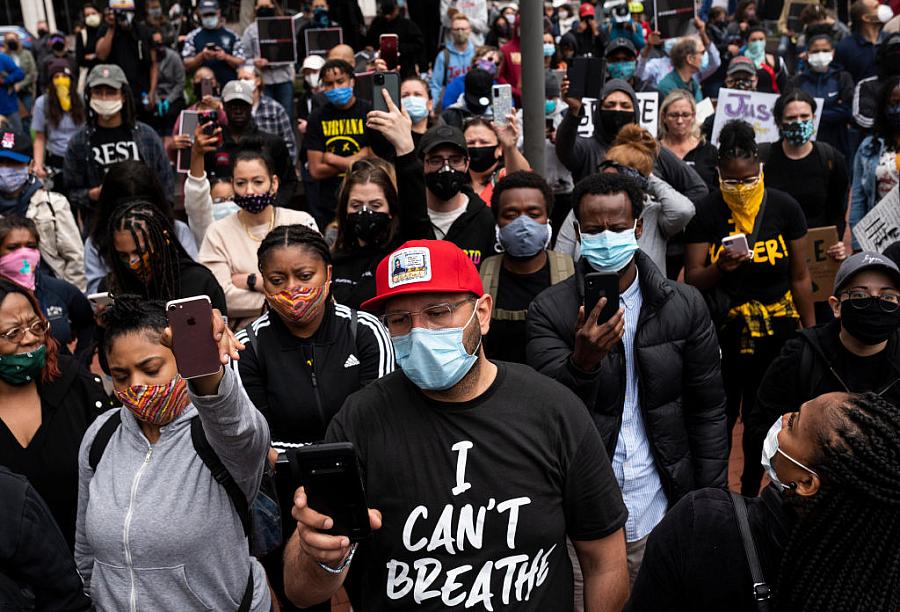'I Can’t Breathe': Justice, journalism and a call for action

(Photo by Stephen Maturen/Getty Images)
The brutal police killings of George Floyd, Breonna Taylor, Ahmaud Arbery, Tony McDade and so many others are inescapable examples of the systematic racism facing Black people in America – unequal treatment that also can pervade school discipline, access to housing and health care.
As protests engulf our nation, we at the USC Center for Health Journalism feel called upon to voice our commitment to journalism that leads to a more just and equitable society.
The Center’s mission is to nurture objective, fact-based reporting that investigates health challenges and solutions in communities, reporting that serves as a catalyst for change.
But that’s a tough road at a time when reporters are being arrested, shot with rubber bullets and sprayed with tear gas and pepper spray. Journalists of color are at elevated risk of being targeted and harassed by police, as the case of Omar Jimenez, the CNN correspondent who was arrested by Minneapolis police while covering a protest, so painfully demonstrates. Freelance photojournalist Linda Tirado lost the vision in her left eye after being shot during a protest with a rubber bullet, she reported. And many other journalists – Black, white, Asian and Latino – have been injured or improperly detained. “I just got hit by a rubber bullet near the bottom of my throat. I had just interviewed a man with my phone at 3rd and Pine and a police officer aimed and shot me in the throat,” Southern California Public Radio reporter Adolfo Guzman-Lopez tweeted on May 31, displaying pictures of the wound on his neck. “OK,” he added, “that’s one way to stop me, for a while.”
The Committee to Protect Journalists reports that between May 29 and June 1, there were at least 125 press freedom violations reported during U.S. protests. And the U.S. Press Freedom Tracker found that since 2017, 75 journalists have been attacked in the U.S. while covering protests.
In 2018, a gunman killed five newspaper employees in their Annapolis, Maryland office.
We call on public officials, on politicians, on police and on demonstrators to set aside the ugly rhetoric that has inflamed emotions and that leads to actions that imperil journalists.
And we ask reporters on the frontlines to continue bravely doing the good work of chronicling and exposing the inequities that are devastating to the health of America’s black and brown communities.
Communities of color in America face twin pandemics – both born of systemic inequity and discrimination. Blacks, in particular, face a far heavier toll from COVID-19 – and from historic disadvantage that has led to what one scholar called “weathering,” premature aging caused by living lives buffeted by discrimination, lack of opportunity, a greater likelihood of living or working in unhealthful conditions and less access to health care.
Other people of color also pay the price for America’s troubled and enduring legacy of racial discrimination. Native Americans suffer disproportionately from COVID-19 and historic racism. The Asian American community is reeling from a surge in racist incidents. Our president, meanwhile, continues to vilify Latino immigrants.
Fear of police and vigilante violence permeates many communities of color and creates toxic stress that shortens lives. The list of hazardous activities for African Americans seems to grow longer every day – from a documented risk of improperly being stopped by police – driving while Black – to bird watching while Black and jogging while Black.
“I just got hit by a rubber bullet near the bottom of my throat… OK, that’s one way to stop me, for a while.” — Southern California Public Radio reporter Adolfo Guzman-Lopez on May 31
Reporting on all this can be exhausting, as Patrice Peck wrote in an essay in The New York Times. “It’s an especially peculiar time to be a Black journalist,” she wrote. “The pandemic has laid bare many of the same racial inequities that generations of Black journalists have been covering since 1827 when the Freedom’s Journal birthed the Black press. While this pandemic is unique, the waves of trauma crashing down on my community are not.”
Easy access to cell phones and social media has made it impossible for the public and authorities to ignore or deny these incidents. Street chroniclers are bearing witness, now serving both as the eyes and ears of journalists and as storytellers and truth tellers in their own right. “The immigrants are definitely our eyes and ears out there,” Pedro Rojas, a McAllen, Texas-based national correspondent for Noticiero Univision, told me, speaking about how he and other colleagues have chronicled deportations, family separations and detentions of undocumented immigrants in private detention facilities. “Since we have been limited by travel and social distancing regulations, many have become our helpers, providing us with video content.”
At the Center for Health Journalism, we work to elevate the stories and the storytellers from all walks of life. Since its founding in 2004, the Center has been committed to supporting journalism on systemic racism and disparities.
In the aftermath of the brutal killing of George Floyd, we offer our support and encouragement to those reporting on the front lines of protests and in communities. We will continue to find ways to help journalists engage the public and address chronic ills in the hard weeks and months to come.

